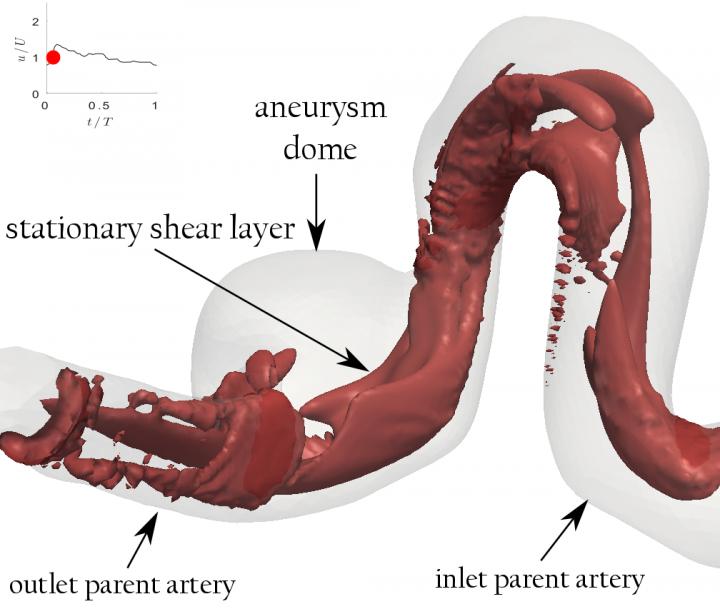Simple parameter that depends on geometry and flow waveform can classify the flow mode into sidewall or bifurcation aneurysms

Credit: Hafez Asgharzadeh, Hossein Asadi, Hui Meng and Iman Borazjani
WASHINGTON, D.C. March 26, 2019 — Aneurysms form as abnormal bulges or balloonings over an artery, and, if ruptured, can lead to serious health complications or even death. Some aneurysms can exist for a long time without rupturing, and the surgery involved in treating aneurysms can be quite risky, so a parameter to help guide surgeons is needed.
Today, treatment decisions are made mainly by assessing the geometric parameters such as the size of an aneurysm, which is obtained from medical images. But the fluid mechanics are known to be an important factor in the initiation, growth and rupture of aneurysms. The factors determined by flow, such as the shear stress and its oscillations on the walls of an artery, require cumbersome flow measurements and numerical simulations. A simple parameter that depends on both flow and geometry, which can substitute flow factors (that require flow measurements and simulations) doesn’t exist.
But now, as researchers from the University at Buffalo and Texas A&M University report in the journal Physics of Fluids, from AIP Publishing, they have developed a simple nondimensional parameter that depends on both geometry and flow waveform to classify the flow mode in both sidewall and bifurcation aneurysms.
“This simple parameter, called ‘aneurysm number (An),’ is the ratio of time scales of two competing phenomena in aneurysms: First is the transport time scale, which represents the transport of a fluid particle through the aneurysm expansion,” said Iman Borazjani, an associate professor at Texas A&M. “Second is the vortex formation time scale, which represents the formation of a vortex due to the pulsatile flow into an expansion.”
The transport phenomenon creates a stationary shear layer through the expansion region, he explained, whereas the vortex phenomenon likes to create a vortex ring. If the transport time scale is smaller (An1) and the flow mode is the vortex mode.
The group’s work is a significant breakthrough because they were able to show that not only can their aneurysm number classify the flow mode in both simplified and anatomic geometries, but also that the oscillations of shear stress are higher in the flow in the vortex mode (An>1). “This means that our simple parameter might be a good substitute for the oscillatory shear parameter — without the need for challenging flow measurements and simulations to calculate shear on the wall,” Borazjani said.
When the researchers first submitted their simplified work, several reviewers questioned whether the results for simplified geometries are applicable to real anatomic ones. “They weren’t convinced, so we had to show that our parameter works for anatomic geometries. Now, a pair of articles are being published together,” Borazjani said, explaining why the group went on to write a second article about their work. They first developed and tested their parameter for simplified (idealized) geometries in part I of their article, and then applied it to anatomic ones in part II.
Oscillatory shear, which is related to the group’s parameter, is thought to affect the endothelial cells and promote inflammation, growth of aneurysms, and even their rupture. For example, “a vortex flow mode is more likely to rupture because it has a higher oscillatory shear,” Borazjani said. “Therefore, we think our simple parameter can help surgeons in making decisions to treat an aneurysm in the future.”
###
The first part of the article, “A non-dimensional parameter for classification of the flow in intracranial aneurysms I: Simplified geometries,” is authored by Hafez Asgharzadeh and Iman Borazjani. The second part, “A non-dimensional parameter for classification of the flow in intracranial aneurysms II: Patient-specific geometries,” is authored by Hafez Asgharzadeh, Hossein Asadi, Hui Meng and Iman Borazjani. The pair of articles will appear in Physics of Fluids on March 26, 2019 (DOI: 10.1063/1.5033942; DOI: 10.1063/1.5081451). After that date, the articles can be accessed at http://aip.
ABOUT THE JOURNAL
Physics of Fluids is devoted to the publication of original theoretical, computational, and experimental contributions to the dynamics of gases, liquids, and complex or multiphase fluids. See http://pof.
Media Contact
Wendy Beatty
[email protected]
Related Journal Article
http://dx.




